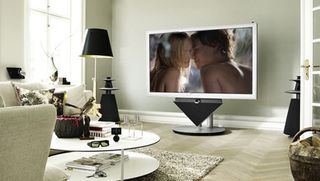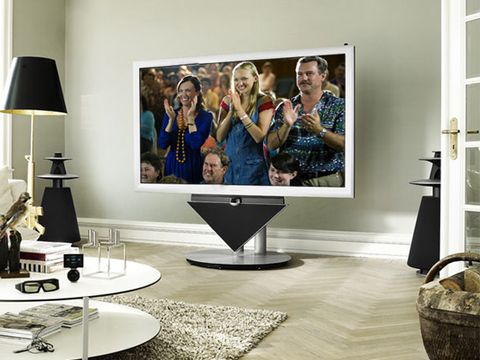Why you can trust TechRadar

At this price the BeoVision 4-85 isn't going to sell in the thousands, which is great news if you're in the market for it, since you can pretty much have it completely customised. Your first choice is between six colours (black, silver, red, blue, golden or gunmetal); the sample we reviewed was finished in snazzy brushed silver.
There's no Freeview HD tuner on board the BeoVision 4-85. If you balk and splutter at that, you're very probably not in Bang & Olufsen's universe. Any situation where the BeoVision 4-85 could be used is also one where a Sky or Virgin box is going to be in place – if only for the plethora of high-definition TV channels – so we're not unduly worried about the lack of DVB-T2. Despite that, we're told it will soon be in place.
In some ways the BeoVision 4-85 is all about cutting out features considered pointless, picture settings being first on the list. It's a strange stance in some ways, because high-end punters should be the fussiest, but Bang & Olufsen has removed virtually all opportunities to tweak the image. Yes, there are some very basic drop-down menus to change contrast, brightness and colour alongside a Game mode, but that is it; everything else is performed automatically by the BeoVision 4-85's ... wait for it … robotic pop-out camera.
Has Bang & Olufsen gone cuckoo? The set arrives perfectly calibrated for its surroundings – B&O is very confident about that, and doesn't want it jeopardised by the customer (heaven forbid) – so the job of the robot arm is to keep things that way.
Partly because plasmas are dynamic, colours can take on a slight yellowing hue the more they're used, so every 90-100 hours of use a five-inch camera pops-up from the top of the display, drops down in front of the screen, and measures the saturations and contrast (from a colour spectrum and a greyscale shown onscreen). It then resets to its original parameters, and adjusts the colour temperature to steer away from yellow and the camera dives back in, cuckoo-clock style.
The whole process (called Automatic Colour management, which can be done manually at any point) takes about 20 seconds, during which time the IR receiver is also measuring the ambient light in the room, and adjusting the brightness accordingly.
It's all a very subtle and silent process, and as we'll see, does a great job, though home cinema aficionados might take umbrage at the apparently dismissive stance towards users making their own tweaks. We presume this stance is largely to stop customers requesting call-outs every time someone messes with the settings.
Aside from magical moving mechanisms, the BeoVision 4-85 is also a 3DTV. It employs the Active 3D system used by (for now) the majority of manufacturers and brands, though that's absolutely no surprise; this is a high-end, and huge, plasma that is ideal for Active 3D.
In and outputs are, again, up to each buyer; on the back of the sample we saw was strapped a BeoSystem 3 surround sound processor that built-in DVI, four HDMI, component video, three electrical digital audio and, remarkably, three Scarts. Also back there were some line ins and outs, analogue and digital RF and an RF modulator.
Current page: B and O BeoVision 4-85: Features
Prev Page B and O BeoVision 4-85: Overview Next Page B and O BeoVision 4-85: PictureJamie is a freelance tech, travel and space journalist based in the UK. He’s been writing regularly for Techradar since it was launched in 2008 and also writes regularly for Forbes, The Telegraph, the South China Morning Post, Sky & Telescope and the Sky At Night magazine as well as other Future titles T3, Digital Camera World, All About Space and Space.com. He also edits two of his own websites, TravGear.com and WhenIsTheNextEclipse.com that reflect his obsession with travel gear and solar eclipse travel. He is the author of A Stargazing Program For Beginners (Springer, 2015),


